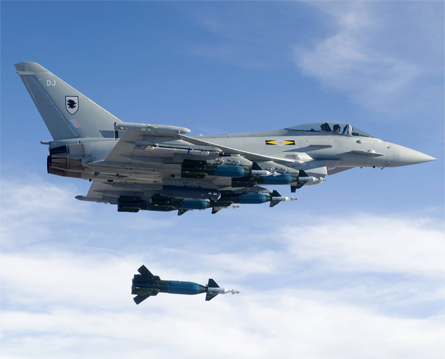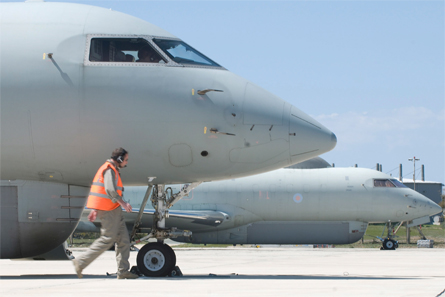The UK Royal Air Force gave the Eurofighter Typhoon its first offensive use on 12 April, when one of its aircraft dropped precision-guided bombs on two Libyan targets.
A joint formation of one Typhoon and one RAF Panavia Tornado GR4 ground-attack aircraft identified three main battle tanks held by forces loyal to Libyan leader Col Muammar Gaddafi to the south of the opposition-held town of Misrata, the Ministry of Defence says.
"The Typhoon successfully engaged two tanks with [Raytheon] Enhanced Paveway II precision-guided bombs, while the Tornado hit another tank with a Paveway IV," it confirms. The aircraft conducted the mission from their forward operating base at from Gioia del Colle in Italy.
Hailing the action as "a significant milestone in the delivery of multi-role Typhoon", chief of the air staff Air Chief Marshal Sir Stephen Dalton says the attacks were conducted "very successfully and very accurately".
While the UK's Eurofighters lack the ability to carry the wide range of weapons and sensors being employed by its Tornado GR4s over Libya and Afghanistan, Dalton told the Royal Aeronautical Society's Aerospace 2011 conference in London that this is "by design and by definition".
RAF Typhoons can now only deploy 454kg (1,000lb) Paveway II-series weapons, but their capabilities are to be progressively enhanced, he says. "The bringing in of Paveway IV, [MBDA's] Brimstone and Storm Shadow is all in the programme for the next three to four years."
 |
|---|
© Geoffrey Lee/Planefocus |
The RAF had previously dropped Paveway II-series weapons only in training |
Armed with 226kg Paveway IVs and lightweight dual-mode Brimstone air-to-surface missiles, Tornado GR4s had until 12 April performed all air strikes conducted by the RAF in support of operations to protect Libyan civilians from pro-Gaddafi forces.
"It has become the norm for each GR4 to take on four or six targets, each of which has been positively identified," Dalton says, while providing an insight into the mechanics of the targeting process during the UK's Operation Ellamy contribution to the NATO-led campaign against Libya.
A typical cycle starts with a Raytheon Systems Sentinel R1 intelligence, surveillance, target acquisition and reconnaissance aircraft operating out of RAF Akrotiri in Cyprus using its synthetic aperture radar to search a wide area for armoured threats. Information is passed to a Boeing E-3D airborne warning and control system aircraft acting as a command and control platform out of the same base.
 |
|---|
© Cpl Dave Blackburn/Crown Copyright |
Two Sentinel R1s are supporting operations from RAF Akrotiri, Cyprus |
Strike aircraft are then cued to conduct a closer check of items of interest using on-board sensors such as the Rafael Litening III targeting pod, before executing their attacks.
Ground moving target information data gathered by US Air Force Northrop Grumman E-8C JSTARS surveillance aircraft can also be relayed to the RAF aircraft via the E-3D.
"Operation Ellamy has proved further validation of the combat ISTAR concept," Dalton says. "Air power has succeeded in denying the regime the conventional use of their artillery, armour and other vehicles. They have found it impossible to hide in streets and around corners, because we now have the technology to find them, and absolutely the weapons to take them out."
He adds: "It is the very combination of our airborne command and control capability of the E-3D Sentry, combined with the critical intelligence collection capability of the Nimrod R1 and Sentinel R1 that are so critical to our success to date."
The RAF's first offensive use of the Typhoon came as France and the UK called on their NATO allies to take on a more active role in prosecuting ground threats in Libya. Although multiple nations are involved in NATO's Operation Unified Protector, many have so far assigned their fighters only to policing the UN-mandated no-fly zone over the country.
However, Dalton singles out the contribution made by the Royal Danish Air Force's detachment of Lockheed Martin F-16s, which is operating out of Sigonella air base in Sicily. "Denmark has proved to be a very willing and capable partner. They've done much more in terms of air-to-ground than we thought they were likely to get involved in," he says. The RDAF says that as of 13 April, its aircraft had flown 90 missions and dropped 166 precision-guided bombs in support of the campaign.
Also highlighting the involvement of military aircraft from Qatar and the United Arab Emirates in the wider operation, he adds: "Overall, we've seen a great deal of coming together."
Source: Flight International























